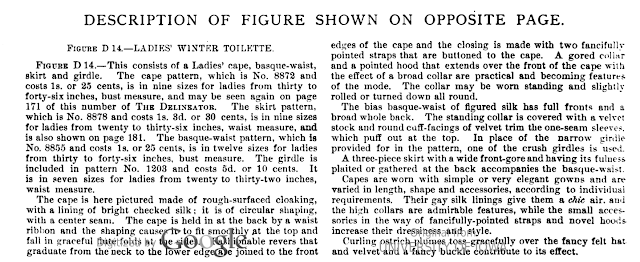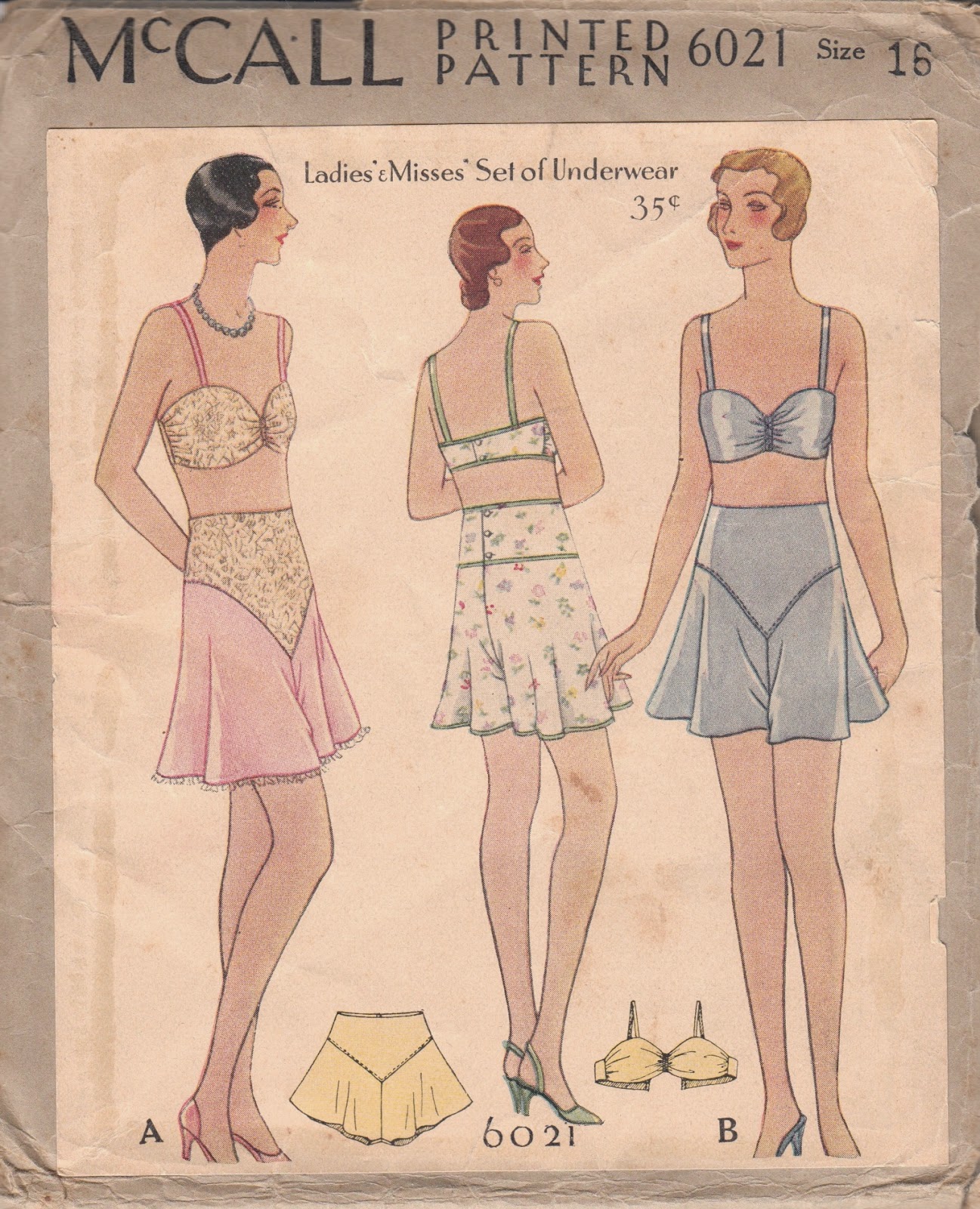The Delineator February 1897 Ensemble | 1890s Fashion
Below is the description of a winter outfit from the February 1897 issue of the Delineator magazine. The Delineator was founded by the Butterick Publishing Company to advertise Butterick sewing patterns. The magazines also included sewing and millinery tutorials, fashion advice, needlework patterns, housekeeping tips, and social news. Click here to read scans of The Delineator from the 1880s to 1930s.
Period magazines and advertisements like this are a great way to better understand how garments were made and fabrics used. They provide context on how and where the outfits should be worn. The pattern descriptions in The Delineator also describe how fabrics widths and which fabrics are suitable to which garments.
Ladies' Winter Toilette
This consists of a Ladies' cape, basque-waist, skirt and girdle. The cape pattern, which is No. 8872 and costs 1s. or 25 cents, is in nine sizes for ladies from thirty to forty-six inches, bust measure, and may be seen again on page 171 of this number of THE DELINEATOR. The skirt pattern, which is No. 8878 and costs 1s. 3d. or 30 cents,* is in nine sizes for ladies from twenty to thirty-six inches, waist measure, and is also shown on page 181. The basque-waist pattern, which is No. 8855** and costs 1s. or 25 cents, is in twelve sizes for ladies from thirty to forty-six inches,*** bust measure. The girdle is included in pattern No. 1208 and costs 5d. or 10 cents. It is in seven sizes for ladies from twenty to thirty-two inches, waist measure.
The cape is here pictured made of rough-surfaced cloaking, with a lining of bright checked silk; it is of circular shaping, with a center seam. The cape is held in at the back by a waist ribbon and the shaping causes it to fit smoothly at the top and fall in graceful flute folds at the sides. Fashionable revers that graduate from the neck to the lower edge are joined to the front edges of the cape and the closing is made with two fancifully pointed straps that are buttoned to the cape. A gored collar and a pointed hood that extends over the front of the cape with the effect of a broad collar are practical and becoming features of the mode. The collar may be worn standing and slightly rolled or turned down all round.
The bias basque-waist of figured silk has full fronts and a broad whole back. The standing collar is covered with a velvet stock and round cuff-facings of velvet trim the one-seam sleeves, which puff out at the top. In place of the narrow girdle provided for in the pattern, one of the crush girdles is used.
A three-piece skirt with a wide front-gore and having its fulness plaited or gathered at the back accompanies the basque-waist.
Capes are worn with simple or very elegant gowns and are varied in length, shape and accessories, according to individual requirements. Their gay silk linings give them a chic air, and the high collars are admirable features, while the small accessories in the way of fancifully-pointed straps and novel hoods increase their dressiness and style.
Curling ostrich plumes toss gracefully over the fancy felt hat and velvet and a fancy buckle contribute to its effect.
Ladies' Cape (Held in the back by a waist ribbon)
No. 8872 - By referring to figure D 14 in this number of THE DELINEATOR, this cape may be seen differently made up.
This is another of the favored styles of cape, a varied assortment of which are now before the devotees of Fashion. It is here pictured made of rough cloth, with gay plaid silk for lining the revers and hood and machine-stitching for a finish. The cape has a center seam and is of circular shaping, with extra widths allowed below the waist at the seam and underfolded in a box-plait. A strap with pointed ends is fastened under buttons over the top of the box-plait and the cape is drawn in to the figure at the back by a belt ribbon tacked underneath and tied in front. The cape fits smoothly at the top and deep, rippling folds fall out around the figure at the sides. Stylish revers are joined to the front edges of the cape; they graduate from the neck, where they are narrowest, to the bottom of the garment, and the closing is effected by two fancifully pointed straps and medium-sized buttons. The neck is completed with a protective collar composed of four gored sections; it may be worn standing and slightly rolled or turned down all round, as shown in the engravings. A modish feature of the cape is the pointed hood, which extends broadly over the shoulders and across the front to give the effect of a deep collar, the ends disappearing under the revers. The outer edge of the hood is finished with a rather wide facing of the cloth machine-stitched to position at the top and shaped by a seam at the center, and an upturning plait at each side throws the hood into pretty folds.
Cloth, seal-plush, velvet and numerous fancy coatings that may be solid-hued or plain on one side and bright-hued on the other are the selections commended for a cape of this style. It may be appropriately worn at the theatre, on the promenade and when riding or travelling.
We have pattern No. 8872 in nine sizes for ladies from thirty to forty-six inches, bust measure. For a lady of medium size, the cape requires five yards and a half of goods twenty-seven inches wide, or four yards and half thirty-six inches wide, or three yards and three-fourths forty-four inches wide, or three yards and five-eighths fifty-four inches wide, with a yard and five-eighths of silk twenty inches wide to line the hood and revers. Price of pattern, 1s. or 25 cents.
Ladies' Three-Piece Skirt, with Wide Front-Gore (to be plaited or gathered at the back)
No. 8878 - By referring to figure No. 117 W and D 14 in this issue, this skirt may be seen differently made up. This skirt is a graceful example of the three-piece variety and is here represented made of novelty dress goods in a dark-brown shade. The skirts consists of a wide front-gore fitted smoothly at the top by a dart at each side of the center and two wide circular portions having bias back edges meeting in a seam at the center of the back. The fulness at the back is collected in two backward-turning plaits at each side of the placket, which is made above the center seam, the plaits expanding gracefully toward the bottom, where the skirt measures a little over four yards and three-eighths round in the medium sizes. Shallow ripples appear at the sides below the hips and roll well toward the back, and a moderate flare is apparent at the foot. The fulness at the back may be collected in gathers, if plaits be not desired, and a belt completes the top of the skirt, which may be worn with a small bustle or with anything that will extend the skirt at the back or without such an appliance.
Silk, cloth, serge and goods of similar weave may be made up in this style, and if decoration is desired, flat bands of velvet, jet, ribbon, etc. may be applied. We have pattern No. 8878 in nine sizes for ladies from twenty to thirty-six inches, waist measure. For a lady of medium size, the skirt will need six yards and seven-eighths of material twenty-two inches wide, or five yards and a fourth thirty inches wide, or four yards and a fourth thirty-six inches wide, or three yards and three-fourths forty-four inches wide, or three yards and five-eighths fifty inches wide. Price of pattern, 1s. 3d. or 30 cents.
Ladies' Bias Basque-Waist, Having a Whole Back (with fitted lining) Desirable for Plaids, Checks, etc.
No. 8855 - By referring to figure No. 88 W in this number of THE DELINEATOR, this basque-waist may be seen differently made up.
The bias effect which makes this waist a most attractive mode is well displayed in the present development, which unites plaid woollen goods and plaid velvet. A lining fitted by double bust darts and the customary seams insures a perfectly trim appearance and the closing is made at the center of the front. The broad, whole back is perfectly smooth-fitting and joins the full fronts in shoulder and under-arm seams. The fronts have fulness collected in gathers along the upper part of the shoulder seam and at the neck at each side of the closing, and two rows of shirring draw the fulness well to the center at the bottom. The lower part of the basque-waist is surrounded by a smooth shallow girdle of velvet shaped by a seam at the right side and closed at the left side. Three square velvet tabs that are joined to the top of the standing collar flare over a crush stock of the plaid goods. The ends of the stock are finished to form frills and the closing is made at the back. The sleeves, which are mounted on coat-shaped linings, have only inside seams; they are gathered at the top to form short puffs below which they are perfectly close-fitting, and two downward-turning plaits in one edge of the seam at the bend of the elbow insures a comfortable adjustment.
Very dressy waists can be made up by the mode of taffeta in a plaid or check pattern or of French poplin or homespun in clan or fancy plaids. These materials should be subdued by combining with them velvet or corded silk in a harmonizing solid color. The combination fabric will generally be used for the girdle and the tabs, which constitute an ornamental feature that adds to the dressiness that characterizes the mode. Several stocks and girdles could be provided to give variety, or the stock in the pattern could occasionally be exchanged for one of ribbon.
We have pattern No. 8855 in twelve sizes for ladies from thirty to forty-six inches, bust measure. For a lady of medium size, the basque-waist requires three yards of plaid goods forty inches wide, with half a yard of velvet twenty inches wide. Of one material, it calls for five yards and an eighth twenty-two inches wide, or four yards thirty inches wide, or three yards and three-fourths thirty-six inches wide, or three yards forty-four inches wide, or two yards and three-fourths fifty inches wide. Price of pattern, 1s. or 25 cents.















